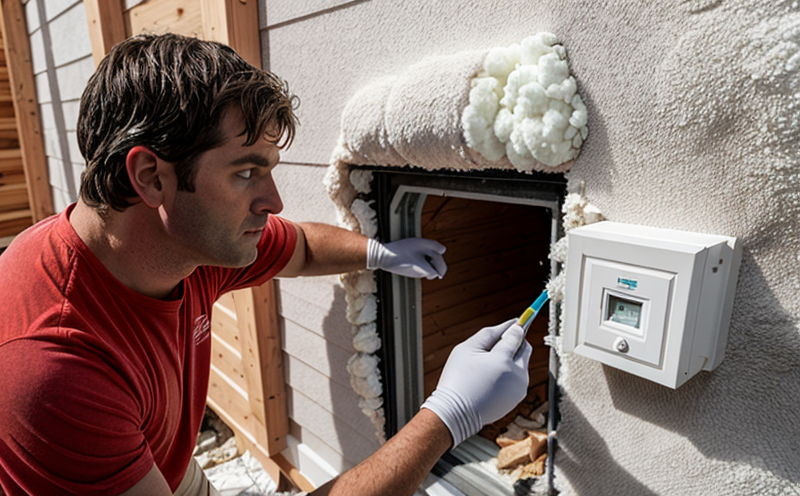ASTM C518 Thermal Conductivity of Insulation Materials
The ASTM C518 test method is a crucial standard used to measure the thermal conductivity of insulating materials. This procedure is essential for ensuring that insulation materials meet specific performance criteria and are suitable for use in various building applications, including walls, roofs, floors, and other areas where heat retention or loss needs to be controlled.
The ASTM C518 test is particularly relevant for those involved in the design and construction of energy-efficient buildings. It helps ensure that insulation materials perform as expected under specific conditions, thereby contributing to overall building efficiency and sustainability. The standard provides a standardized method for testing thermal conductivity at steady-state conditions using a guarded-hot plate apparatus.
The specimen used for this test is typically a rectangular block cut from the material being evaluated. The dimensions of these specimens are carefully controlled according to ASTM C518 specifications, ensuring consistency across different tests and laboratories. During the test, heat flows through the specimen in two directions: parallel to the surface (longitudinal) and perpendicular to it (transverse). By measuring both values, engineers can better understand how effectively the insulation material will perform under real-world conditions.
The results of ASTM C518 testing provide valuable data that helps architects, builders, and engineers select appropriate materials for their projects. This information is critical when designing systems intended to maintain optimal interior temperatures while minimizing energy consumption associated with heating or cooling processes. Additionally, compliance with this standard ensures consistency in product quality across manufacturers, enhancing trust among end-users who rely on reliable performance from these materials.
Compliance with ASTM C518 also supports broader industry goals related to reducing environmental impact through more efficient use of resources and reduced greenhouse gas emissions associated with energy production. As building codes increasingly emphasize sustainability practices, having access to accurate thermal conductivity measurements becomes even more important for meeting regulatory requirements.
In summary, the ASTM C518 test is an indispensable tool for verifying that insulation materials meet necessary performance standards. Its application extends beyond mere quality control; it plays a significant role in shaping future trends within the construction sector by promoting innovation and best practices aimed at improving energy efficiency and reducing environmental footprints.
Applied Standards
The ASTM C518 test method is widely recognized as an authoritative standard for determining the thermal conductivity of insulating materials. It aligns closely with other international standards such as ISO 8302, which also covers similar testing techniques but may have slightly different requirements based on regional preferences.
- ASTM C518
- ISO 8302
- EN 12667
The consistency between these standards ensures that results obtained from one standard can be compared meaningfully with those derived using another. This interoperability is particularly important for global markets where multiple jurisdictions may require compliance with different sets of regulations.
In addition to these formalized standards, ASTM C518 has been adopted by many organizations and institutions around the world as a best practice guideline for testing insulation materials. Its widespread acceptance reflects its reliability and accuracy in providing consistent results across diverse environments and applications.
Customer Impact and Satisfaction
The implementation of ASTM C518 testing offers numerous benefits for customers in the building & infrastructure sector, particularly those involved in quality management, compliance, R&D, and procurement. By ensuring that insulation materials meet necessary performance standards, this test enhances customer satisfaction by delivering reliable products.
- Enhanced Quality Control
- Improved Product Performance
- Better Compliance with Regulations
- Increased Confidence in Supplier Partnerships
Quality managers can rest assured knowing that their suppliers adhere to rigorous testing protocols, leading to higher quality outputs. Compliance officers benefit from reduced risk of non-compliance issues and enhanced credibility within regulatory frameworks.
R&D engineers gain valuable insights into material properties which aid in developing innovative solutions for improved insulation performance. For procurement professionals, consistent performance across different manufacturers is guaranteed, fostering trust among suppliers.
Ultimately, the widespread adoption of ASTM C518 contributes positively towards sustainable construction practices and energy-efficient buildings, ultimately enhancing customer satisfaction through better-performing structures that contribute to long-term savings on heating and cooling costs.
Competitive Advantage and Market Impact
The ability to consistently meet or exceed ASTM C518 standards provides significant competitive advantages in the marketplace. Builders, architects, and developers can differentiate themselves by offering high-quality insulation solutions that not only meet but surpass industry expectations.
Companies that invest in rigorous testing procedures like those outlined in ASTM C518 are seen as leaders within their respective industries. This reputation translates into increased market share, customer loyalty, and long-term profitability.
The standard also plays a role in shaping future trends within the construction sector by promoting innovation and best practices aimed at improving energy efficiency and reducing environmental footprints. As building codes increasingly emphasize sustainability practices, having access to accurate thermal conductivity measurements becomes even more important for meeting regulatory requirements.





